Dinosaurs are great. They dominated the world for over 170 million years, and one line has survived to the present day as birds. But they’re hardly the be-all and end-all of prehistory. In the wake of the mass extinction that wiped out the non-avian dinosaurs, prehistoric mammals proliferated into a variety of astounding forms that were just as fantastic as those of the dinosaurs they succeeded. Instead of letting them be persistently overshadowed by dinosaurs, it’s time to give fossil mammals their due.
Uintatherium
Even if you haven’t heard of Uintatherium before, chances are you’ve seen one. The rhino-sized, knobbly-headed, saber-toothed herbivores are museum mainstays and often included in packs of plastic prehistoric creatures. Despite the mammal’s fame, though, these strange creatures are enigmas even to experts.
Uintatherium is a Bone Wars beast, named by Philadelphia naturalist Joseph Leidy in 1872. Since that time paleontologists have found out a bit about the natural history of Uintatherium—that it likely browsed on relatively soft vegetation, had a small brain, and those impressive canine teeth differed in length between the sexes—but one overarching mystery remains.
Uintatherium roamed America’s prehistoric west between 50 and 40 million years ago at a time when bizarre, archaic mammals were dominant. That has complicated efforts to figure out what sort of mammal Uintatherium actually was. The strange mammal and its kin have been cast as early ungulates, relatives of other totally-extinct groups, and even as early, distant cousins of rabbits. Wherever Uintatherium fits into the mammal family tree, though, it was truly one of the most spectacular beasts of all time.
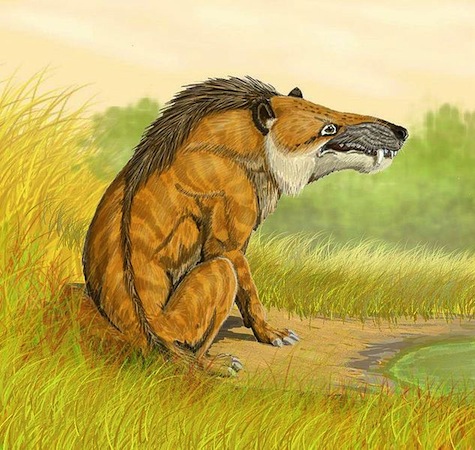
Andrewsarchus
During a 1923 expedition to the Gobi Desert, paleontologists on an American Museum of Natural History discovered the huge skull of a carnivorous mammal. Nearly three feet long and still possessing fist-sized teeth that would have chawed flesh and cracked bone, the cranium belonged to an animal the researchers dubbed Andrewsarchus. For years artists restored the animal as a wolfish predator—think of a real life version of Gmork from The Neverending Story—but more recent research has made Andrewsarchus even stranger.
Andrewsarchus lived sometime between 45 and 36 million years ago. How the carnivore went about stalking and dismantling prey during that time is frustrated by the fact that only the skull and a few accompanying bone scraps have ever been found. Still, from that skull and the mammal’s relationship to an extinct group of “hell pigs” called entelodonts, Andrewsarchus likely ran after prey on long, stout legs tipped in hoofed toes that brought the carnivore close enough to deliver a devastating bite powered by thick neck muscles. With any luck, future fossil finds will tell paleontologists how close the real nightmare was to the reconstructed version.
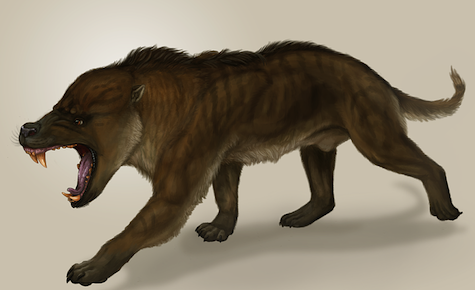
Amphicyon
The name Amphicyon translates to “ambiguous dog.” That fits. This eight-foot-long, burly carnivore looked like a fearsome combination of bear and dog. And with several species spread through Africa, Eurasia, and North America between 21 and 9 million years ago, these carnivorans were clearly successful.
Exactly what large bear dogs like Amphicyon ate is only known from rare fossil associations. Even though bear dogs look like they could’ve taken down large prey, a 9 million year old aggregation of damaged musk deer skeletons found in Spain suggests that these predators at least sometimes chased down prey smaller than themselves. Then again, in Portugal, paleontologists have found an even older rhino skeleton scored by Amphicyon tooth marks. Whether the bear dog killed the rhino or scavenged the carcass isn’t clear. The bear dog certainly looked capable of doing either.
Gigantopithecus
Prehistoric apes never got close to King Kong size, but Gigantopithecus was still one impressive primate.
First discovered as a curious tooth in a Bangkok apothecary shop in 1935, Gigantopithecus is thought to have been almost ten feet tall when standing upright and weigh about 1,200 pounds. These are rough estimates, though, as very little of the Gigantopithecus skeleton has been found. Paleontologists have accumulated hundreds of teeth and several lower jaws, but nothing more. Quite frustrating for a huge ape that inhabited Asia between about 1 million and 10,000 years ago and that prehistoric humans likely saw in the flesh.
All the same, teeth are rich sources of fossilized information about prehistoric creatures. In the case of Gigantopithecus, the shape and microscopic details of teeth collected so far suggest this prehistoric cousin of organutans fed on fruit, seeds, and bamboo. Too bad all the non-avian dinosaurs were long dead by time Gigantopithecus was dining on the undergrowth, further dashing King Kong dreams.
Amebelodon
Elephants are among the strangest and most impressive of mammals, but their prehistoric cousins were even weirder. Chief among the long-lost elephantine oddballs was Amebelodon—a “shovel tusker” that tromped across North America and Asia between 9 and 5 million years ago.
Instead of the short, high skull of living elephant species, Amebelodon had an extraordinarily long face with two prominent, squared tusks jutting out from the lower jaw. How this extinct proboscidean used such dental tools is a puzzle.
Some researchers took their shovel-like appearance at face value and suggested that Amebelodon scooped soft water plants from Miocene marshes. But, based on subtle damage to those tusks, in paleontologist W. David Lambert has suggested something different. Instead of being stuck in swamps, these elephants were able to tackle a greater range of vegetation and may have even used their trunks and tusks in conjunction to saw through tough plants. Time will tell if the saw-tusker title catches on.
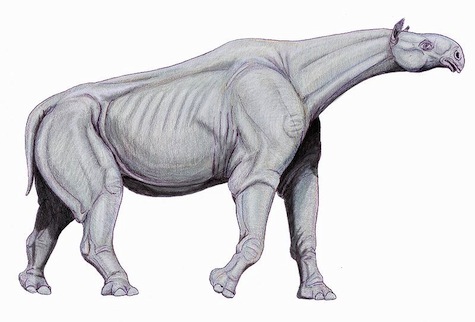
Paraceratherium
Paraceratherium was a terrestrial titan. Stretching 26 feet long and weighing up to 20 tons, this prehistoric relative of living rhinos was the largest land mammal of all time.
Don’t let the relationship fool you. Like most rhinos throughout prehistory, Paraceratherium didn’t have a horn. The form of the herbivore was more like a rhino in a giraffe-like shape, with a large head balanced on a long neck that allowed Paraceratherium to browse high in the trees of Eurasia between 35 and 20 million years ago.
Why such giant, tree-cropping rhinos disappeared is a mystery, but archaic elephants may have had something to do with it. As articulated by paleontologist P.V. Putshkov, prehistoric proboscideans that moved into Paraceratherium habitat may have pushed over trees to get at some of the leafy greens up top and literally changed the landscape in a way that left tree-dependant Paraceratherium starving. Who knows whether evolution will ever spin off another mammal as enormous as the lost rhino.
Thalassocnus
Despite their sluggishness, living sloths are skilled swimmers. But one of their giant, prehistoric relatives was even better. That was Thalassocnus, the seashore sloth.
Between 8 and 2 million years ago the ancient coast of Peru was home to a succession of five species of Thalassocnus, with each slightly more adapted to an amphibious life than the last. From the shape of the skulls and scratches on teeth created by ancient beach sand, paleontologist Christian De Muizon and colleagues have suggested that these sloths started out snarfing stranded seaweed that washed up along the shore and occasionally dipped their heads into the shallows to feed. Over time, however, the sloths started venturing further out into the water, anchoring themselves to the bottom with their huge claws as they plucked and chewed aquatic vegetation. Whether these fossil species were as adorable as modern baby sloths is an open question.
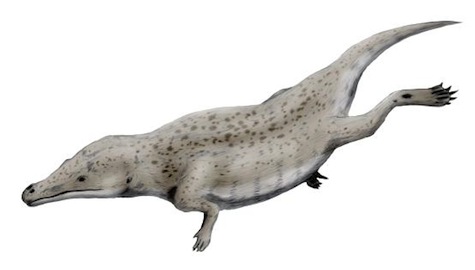
Maiacetus
There were once walking whales. A fantastic array of fossils from Asia, Africa, and North America have allowed paleontologists to retrace how ancestral cetaceans walked into the surf and became increasingly adapted to life at sea between 50 and 40 million years ago. And of all the early whales found so far, Maiacetus is the most beautifully-preserved.
Maiacetus was a whale caught in the middle. The skull, limbs, and spine of the cetacean were already well-suited to a mostly-aquatic life, as shown by a pair of fantastic skeletons paleontologist Philip Gingerich and coauthors described in 2009. Both were startlingly complete and still articulated—rare for any fossil vertebrates—but one specimen contained a surprise.
Preserved inside the ribcage of one Maiacetus was the partial skeleton of a young individual. Gingerich and colleagues interpreted the bonus fossil as a fetus, hence the scientific name translating to “Mother whale” for the beast. But paleontologists J. G. M. Thewissen and William McLellan raised another possibility—perhaps the little one wasn’t a fetus, but “a calf and was cut into pieces by the larger individual and then partly ingested.” The debate remains, leaving it uncertain whether the moniker Maiacetus should be taken literally or with irony.
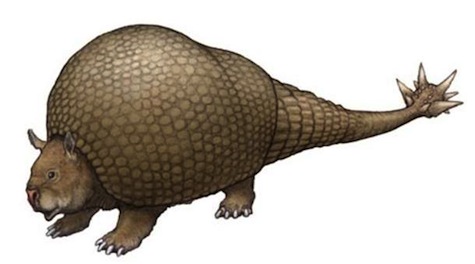
Doedicurus
Imagine a heavily-armored sloth with a morning star for a tail. That’s a good approximation of Doedicurus. One of the glyptodonts, a diverse group of armadillo relatives encased in bone armor, this 13-foot-long mammal was a living tank that trundled across South America between 2 million and 15,000 years ago.
What makes Doedicurus immediately recognizable to fossil fans is the nasty tail club. Many glyptodonts had some sort of caudal weaponry, but the remains of Doedicurusstand out for resembling a bony bat with large pockmarks around the tip. These divots supported long spikes in life, although exactly what the herbivore used them for isn’t clear. The shell of Doedicurus was so large that the beast probably couldn’t have seen what it was swinging at. That’s not the best defensive strategy. Instead, paleontologist R. Ernesto Blanco and collaborators have proposed that glyptodonts were swinging these intimidating weapons at each other. Just think of the sound club-on-shell would have made.
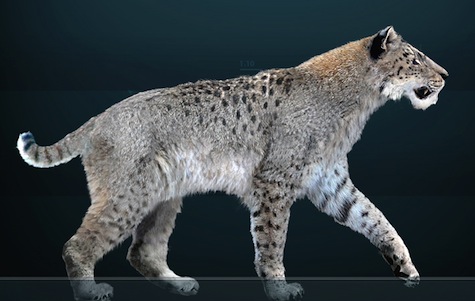
Homotherium
Smilodon is undoubtedly the most famous of the great sabercats, but Homotherium deserves just as much attention. A “scimitar-toothed cat” with elongated canines and a lanky build, Homotherium was a lion-sized carnivore that spread from Africa through Eurasia and the Americas between 5 million and 10,000 years ago. For most of human prehistory, Homotherium was right there with us.
As with other Ice Age sabercats, only bones and degraded DNA testify to the life of Homotherium. Yet there is one spectacular site in Texas that illuminates just how clever this cat was. San Antonio’s Friesenhahn Cave is a sinkhole that Homotherium used as a den. In addition to the remains of several Homotherium individuals, including saberkittens, the cave is replete with the bones of young mammoths. From the details of the bones, adult Homotherium would either kill or scavenge a baby mammoth, dismember a limb, and drag their meal back to the safety of their cave where they could gnaw mammoth flesh at their leisure. In short, Homotherium did has mammothburger.
Brian Switek is the author of My Beloved Brontosaurus and Written in Stone. He also writes the National Geographic blog Laelaps









